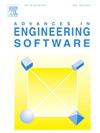Inflatable design and deployment morphology of conical Kresling origami structures
IF 5.7
2区 工程技术
Q2 COMPUTER SCIENCE, INTERDISCIPLINARY APPLICATIONS
引用次数: 0
Abstract
Inflatable capsules and tubular structures have been widely used in solar panels, floating platforms, and energy-absorbing components due to their beneficial characteristics, such as lightweight construction and convenient deployment. However, most traditional inflatable capsules require rigidification to maintain their stiffness and deployed shapes, which introduces additional complexity and challenges, especially in space exploration. In this study, we propose an inflatable cone based on the conical Kresling origami pattern, capable of achieving high surface flatness and a large deployment ratio without the need for rigidification. To this end, an improved design method for multi-layer conical origami structures is introduced. The folding and deployment processes of cones with various geometric parameters are analyzed through numerical simulations, focusing on maximum plastic strain, deployment ratio, and surface flatness. The results reveal that conical origami structures with a single chirality exhibit superior surface flatness. Increasing the number of creases and the arc radius can effectively reduce maximum plastic strain. However, excessive creases and an overly large arc radius can negatively impact both the deployment ratio and surface flatness. Additionally, reducing the structure's conicity lowers the deployment ratio and plastic strain but has little effect on surface flatness. The proposed inflatable metallic cone shows strong potential for applications in aerospace and structural engineering.
锥形Kresling折纸结构的充气设计与展开形态
充气胶囊和管状结构由于具有结构轻、部署方便等优点,在太阳能电池板、浮动平台和吸能部件中得到了广泛的应用。然而,大多数传统的充气式太空舱需要硬化来保持其刚度和展开形状,这带来了额外的复杂性和挑战,特别是在太空探索中。在这项研究中,我们提出了一种基于锥形Kresling折纸图案的充气锥体,能够在不需要硬化的情况下实现高表面平整度和大展开比。为此,介绍了一种改进的多层锥形折纸结构设计方法。通过数值模拟分析了锥体在不同几何参数下的折叠展开过程,重点分析了最大塑性应变、展开比和表面平整度。结果表明,具有单手性的锥形折纸结构具有较好的表面平整度。增加折痕数和圆弧半径可以有效降低最大塑性应变。然而,过多的折痕和过大的弧半径会对展开比和表面平整度产生负面影响。此外,减小结构的锥度可以降低展开比和塑性应变,但对表面平整度影响不大。所提出的可充气金属锥在航空航天和结构工程方面具有很大的应用潜力。
本文章由计算机程序翻译,如有差异,请以英文原文为准。
求助全文
约1分钟内获得全文
求助全文
来源期刊

Advances in Engineering Software
工程技术-计算机:跨学科应用
CiteScore
7.70
自引率
4.20%
发文量
169
审稿时长
37 days
期刊介绍:
The objective of this journal is to communicate recent and projected advances in computer-based engineering techniques. The fields covered include mechanical, aerospace, civil and environmental engineering, with an emphasis on research and development leading to practical problem-solving.
The scope of the journal includes:
• Innovative computational strategies and numerical algorithms for large-scale engineering problems
• Analysis and simulation techniques and systems
• Model and mesh generation
• Control of the accuracy, stability and efficiency of computational process
• Exploitation of new computing environments (eg distributed hetergeneous and collaborative computing)
• Advanced visualization techniques, virtual environments and prototyping
• Applications of AI, knowledge-based systems, computational intelligence, including fuzzy logic, neural networks and evolutionary computations
• Application of object-oriented technology to engineering problems
• Intelligent human computer interfaces
• Design automation, multidisciplinary design and optimization
• CAD, CAE and integrated process and product development systems
• Quality and reliability.
 求助内容:
求助内容: 应助结果提醒方式:
应助结果提醒方式:


